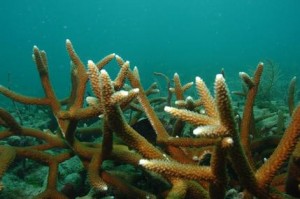http://www.miamiherald.com/2010/01/27/1447907/coral-in-keys-suffers-lethal-hit.html
Coral bleaching, usually triggered by hot weather, erupted after this month’s cold snap, devastating shallow water corals across the Florida Keys.
BY CURTIS MORGAN
cmorgan@MiamiHerald.com
Bitter cold this month may have wiped out many of the shallow water corals in the Keys.
Scientists have only begun assessments, with dive teams looking for “bleaching” that is a telltale indicator of temperature stress in sensitive corals, but initial reports are bleak. The impact could extend from Key Largo through the Dry Tortugas west of Key West, a vast expanse that covers some of the prettiest and healthiest reefs in North America.
Given the depth and duration of frigid weather, Meaghan Johnson, marine science coordinator for The Nature Conservancy, expected to see losses. But she was stunned by what she saw when diving a patch reef 2 ½ miles off Harry Harris Park in Key Largo.
Star and brain corals, large species that can take hundreds of years to grow, were as white and lifeless as bones, frozen to death. There were also dead sea turtles, eels and parrotfish littering the bottom.
“Corals didn’t even have a chance to bleach. They just went straight to dead,” said Johnson, who joined teams of divers last week surveying reefs in the Florida Keys National Marine Sanctuary. “It’s really ecosystem-wide mortality.”
The record chill that gripped South Florida for two weeks has taken a heavy toll on wildlife — particularly marine life.
On Tuesday, the Florida Fish and Wildlife Conservation Commission reported that record numbers of endangered manatees had already succumbed to the cold this year — 77, according to a preliminary review. The previous record, 56, was set last year. Massive fish kills also have been reported across the state. Carcasses of snook and tarpon are still floating up from a large fish kill across Florida Bay and the shallow waters of Everglades National Park.
Many of the Florida Keys’ signature diving destinations such as Carysfort, Molasses and Sombrero reefs — as well as deeper reefs off Miami-Dade and Broward — are believed to have escaped heavy losses, thanks to warming effects of the Gulf Stream. But shallower reefs took a serious, perhaps unprecedented hit, said Billy Causey, Southeast regional director of national marine sanctuaries for the National Oceanic and Atmospheric Administration.
PAST PROBLEMSCoral-bleaching has struck the Keys in the past, most recently twice in the 1990s, preceding a die-off that claimed 30 percent of the reef tract. But those events, along with others that have hit reefs around the world, have usually been triggered by water hotter than what corals typically tolerate.
Healthy corals depend on a symbiotic relationship between polyps, the living tissues that slowly build the hard outer skeletons that give species distinctive shapes, and algae called zooxanthellae that give them their vibrant colors. But when ocean temperatures veer from their comfort zone too much or too long, the coral begin to shed that algae, turning dull or a bleached bone-white.
The effect usually doesn’t immediately kill coral but can weaken it, slowing growth and leaving fragile reefs — home to millions of fish, crabs and other animals — more vulnerable to diseases, pollution and damage from boaters and divers.
Cold-water bleaching is unusual, last occurring in 1977, the year it snowed in Miami. It killed hundreds of acres of staghorn and elkhorn corals across the Keys. Neither species has recovered, both becoming the first corals to be federally listed as threatened in 2006.
This big chill, said Causey, shapes up worse.
“They were exposed to temperatures much colder, that went on longer, than what they were exposed to three decades ago,” he said.
Typical winter lows in-shore hover in the mid- to high-60s in the Keys.
At its coldest more than a week ago, a Key Largo reef monitor recorded 52. At Munson Reef, just about a half-mile off the Newfound Harbor Keys near Big Pine Key, it hit 56.
At Munson Reef, said Cory Walter, a biologist for Mote Marine Laboratory in Summerland Key, scientists saw losses similar to what was reported off Key Largo. Dead eels, dead hogfish, dead coral — including big coral head five- to six-feet wide, bleached white with only fringes of decaying tissue.
“They were as big, as tall, as me. They were pretty much dead,” said Walter, who coordinates Mote’s BleachWatch program, which monitors reefs.
The dividing line for damage seems to be Hawk Channel, which parallels the Keys on the Atlantic Ocean side.
East of the channel, at reefs such as Looe Key, one of the top tourist sites, there was only light paling on some coral, she said. In Hawk Channel itself, there were dead sponges and stressed corals but not many outright dead ones.
SURVEYING DAMAGEWest of the channel toward shore, damage was more serious. Walter estimated 75 percent coral loss at one patch reef, though with poor visibility, it was a limited survey. Some nurseries growing small staghorn and elkhorn corals for restoration programs also may have been hard hit.
Over the next few weeks, scientists and divers from the Florida Keys National Marine Sanctuary, National Park Service, Florida Fish & Wildlife Conservation Commission, Mote Marine Laboratory, the University of Miami, Nova Southeastern University and other organizations will try to get a more completepicture of damage with reef surveys as far northas Martin County and as far south as the Dry Tortugas.
While they may not be able to save cold-damaged corals, Causey said, chronicling what dies and, more importantly, what survives, will help coral researchers in the future.
“We’re going to know so much more about this event than any other event in history,” he said.

